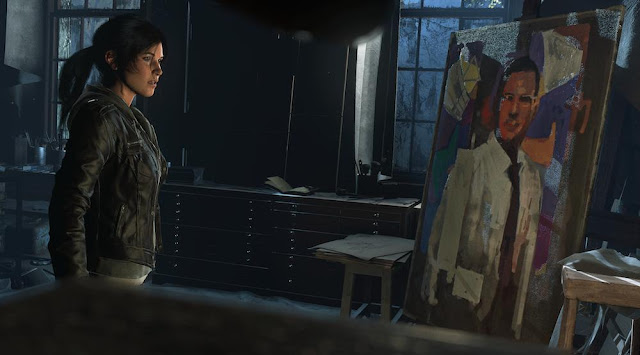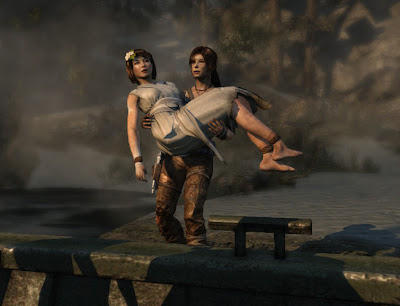Rise of the Tomb Raider: Blood Ties – Past, present and future mesh in this emotionally powerful DLC
Pre-play musings
Daddy issues.
If you want to dislike Angelina Jolie’s 2001 Tomb Raider film for one reason, it’s that the movie forced parental hang-ups into the franchise mix. Thanks to Hollywood, Lara Croft’s origin story shifted dramatically. And not for the better.
Twenty years ago, Lara Croft was conceptualised as having survived a plane crash in the mountains. The trek back to civilisation profoundly affects her priorities. She promptly abandons her life of aristocratic privilege for one of adventure – which gets her disowned by her parents. It doesn’t matter though; she achieves success by living life on her own terms as a self-made woman.
After the Tomb Raider movie was released, however, aspects of the blockbuster backstory began to surface in the games. With the release of 2006’s Tomb Raider: Legend, Lara was rewritten as a young woman who loses her mother at a young age and is raised alone by her unorthodox archaeologist father. Once her dad is also lost to his obsessive quest for answers, Lara takes up his mantle and mission.
On the level of critical theory, this post-2001 change can be interpreted as a reduction in agency for the character of Lara Croft. From making a conscious choice to start a new life – cognisant of the sacrifices it entails – the adventurer is reimagined as someone who essentially continues the family business. From charting her own course, the Tomb Raider becomes a follower on a well-worn track; her identity forever linked to a male figure. (See also Wonder Woman’s reimagining as Zeus’s daughter).
It’s a problematic shift – especially when examined at an analytical level – but it’s not all bad.
Because A) the subject of paternal influence can actually still be handled with nuance that does not subordinate the heroine. Most recent game release Rise of the Tomb Raider does this surprisingly well.
And B) without the family focus of Lara Croft’s newer origin tale, we wouldn’t have one of the most profoundly moving and lore-rich Tomb Raider experiences of all time: Blood Ties.
The Blood Ties basics
Blood Ties is brand new DLC made available with the release of Rise of the Tomb Raider: 20 Year Celebration from 11 October. If you haven’t played the main game before, you have to reach the first Siberian base camp – completing the entire Syrian chapter – before Blood Ties becomes accessible in the main menu.
Blood Ties is in essence a story-driven side campaign, with some similarities to the one found in Tomb Raider: Anniversary. Completely combat-free, you explore Croft Manor as a weary-sounding Lara (there’s also a first-person VR mode on PS4), looking for clues about your family’s past, and solving related puzzles. It’s not simply a matter of curiosity, though. Your uncle, Atlas – your mother’s brother – is contesting your inheritance rights, and you need to find proof that will secure the estate for you.
Blood Ties can apparently be completed in an hour or so, although fans will likely want to take their time savouring every discovery. Depending on your puzzle-solving skills, and how engrossed you become in the content, the DLC could take you upwards of two and a half hours.
Pleasurably lost in layers of lore
So why is Blood Ties absolutely worth your time?
Well, it turns out Daddy issues become a lot more palatable when they centre on “real” people. Starting with 2013’s Tomb Raider, the rebooted games have done a lot flesh out the new, younger Lara Croft, and that trend continues in Blood Ties. Not only that, but this relatability extends to Lara’s parents for the first time.
[Spoilers start]
Even though Richard Croft’s voice recordings feature prominently in Rise of the Tomb Raider’s main content, there has until now been no sense of him as anything other than an archaeologist obsessed with immortality myths. That’s it. But Blood Ties fills in a gaping hole in the reboot franchise: the fate of Lara’s mother, Amelia. In doing so, the player is exposed to Richard and Amelia’s courtship and marriage, and we get a far better sense of the Crofts as multi-dimensional people.
Predominantly we see that relationships with passionate, work-focused individuals can be additive in terms of the encouragement and excitement they provide. The flipside of this is that the distraction and emotional aloofness of those same individuals can drive partners away. It’s not easy no matter how much you love one another.
Amelia’s story of courage, sacrifice and wasted potential is especially tragic. Meanwhile, we see Richard coming to terms with his grief and guilt in some very unhealthy ways – for himself and his daughter. He emerges as a deeply flawed man, trying desperately to make up for his mistakes. Who doesn’t know that feeling?
[Spoilers end]
This part of the story feels so authentic that at times, as you move through the dilapidated manor – picking up letters, journals, recordings and artefacts – it can feel uncomfortable, like you’re poking about unwelcome in a family’s warts-and-all personal history.
This review is starting to make Blood Ties sound like a downer, but that isn’t true. There is so much to be enjoyed on every level. The DLC may cover the Croft family past, but it also pays tribute to 20 years of franchise history. It’s stuffed with Easter eggs that should please fans of Old and New Lara.
[Spoilers start]
A gramophone plays a familiar theme, Lara gushes over a small jade dragon, and a good deal of Classic Lara’s backstory has been shifted onto Amelia. Then there are the references to a certain butler, who’s reimagined here as having a supportive, fatherly bond with Lara very similar to that between Bates and Lady Mary in Downton Abbey.
[Spoilers end]
Newer franchise additions haven’t been neglected either. There’s no Rhianna Pratchett on the writing team this time, but from Pratchett’s comics run you’ll recognise Reginald the Knight, and reference to Jaffa Cakes as Lara’s favourite treat. For the record, Blood Ties was completed in-house at Crystal Dynamics, in conjunction with Nixxes. Narrative Director John Stafford and franchise Creative Director Noah Hughes worked on the story, with contributions from Cameron Suey.
There is a lot that is touching in Blood Ties, as well as some very nice touches. The attention to detail in realising Croft Manor is phenomenal. In VR, it must be glorious. Even in standard play though, there is loads to appreciate. For example, a simple but thoughtful inclusion is having Lara evidently camped out on a couch in the hallway leading to the study. It counterpoints well with a childhood “nest” found later on; very convincing as something an adventurous little girl would make.
In addition to the visual delights, Blood Ties offers a treasure trove of information about Lara and the Croft family: the origins of Lara’s name, where she was appropriately conceived, what the Croft family crest looks like. The DLC acts as a handy backstory information pack for fanfiction writers, and anyone who wants to know more about the Tomb Raider’s childhood.
In terms of gameplay, Blood Ties is also appreciably well-thought-out. As already said, it’s combat-free and you’re wandering around a manor house. This doesn’t mean, however, that the game retains one pace throughout. You’re never bored. Blood Ties has been cleverly structured so that the principle of rising action still applies. The design – the “gates” you pass through as certain puzzles are solved and new areas unlock – allow the mystery to amplify and the tension to rise.
It all leads to a resonant ending that, after building for so long, delivers a jab straight in the feels. You may question the legal power of Lara’s final discovery (I did), but the lingering impression of Blood Ties is that it’s a tale of family secrets and love done right. Some may find it sentimental, but I found it dark, unsettling and beautiful – a family counselling session in the form of an engrossing video game.
Because, best of all, Blood Ties offers very satisfying closure (to continue the therapy metaphor). By the end, Lara has achieved a better understanding of her parents, their motivations and their wishes for her. Our heroine is perfectly positioned to move forward in life with no more hang-ups about her folks. And with the Daddy issues resolved, the Tomb Raider is once more free to create her own path, heading off into the unknown without others' footsteps leading the way.
Daddy issues.
If you want to dislike Angelina Jolie’s 2001 Tomb Raider film for one reason, it’s that the movie forced parental hang-ups into the franchise mix. Thanks to Hollywood, Lara Croft’s origin story shifted dramatically. And not for the better.
Twenty years ago, Lara Croft was conceptualised as having survived a plane crash in the mountains. The trek back to civilisation profoundly affects her priorities. She promptly abandons her life of aristocratic privilege for one of adventure – which gets her disowned by her parents. It doesn’t matter though; she achieves success by living life on her own terms as a self-made woman.
After the Tomb Raider movie was released, however, aspects of the blockbuster backstory began to surface in the games. With the release of 2006’s Tomb Raider: Legend, Lara was rewritten as a young woman who loses her mother at a young age and is raised alone by her unorthodox archaeologist father. Once her dad is also lost to his obsessive quest for answers, Lara takes up his mantle and mission.
On the level of critical theory, this post-2001 change can be interpreted as a reduction in agency for the character of Lara Croft. From making a conscious choice to start a new life – cognisant of the sacrifices it entails – the adventurer is reimagined as someone who essentially continues the family business. From charting her own course, the Tomb Raider becomes a follower on a well-worn track; her identity forever linked to a male figure. (See also Wonder Woman’s reimagining as Zeus’s daughter).
It’s a problematic shift – especially when examined at an analytical level – but it’s not all bad.
Because A) the subject of paternal influence can actually still be handled with nuance that does not subordinate the heroine. Most recent game release Rise of the Tomb Raider does this surprisingly well.
And B) without the family focus of Lara Croft’s newer origin tale, we wouldn’t have one of the most profoundly moving and lore-rich Tomb Raider experiences of all time: Blood Ties.
The Blood Ties basics
Blood Ties is brand new DLC made available with the release of Rise of the Tomb Raider: 20 Year Celebration from 11 October. If you haven’t played the main game before, you have to reach the first Siberian base camp – completing the entire Syrian chapter – before Blood Ties becomes accessible in the main menu.
Blood Ties is in essence a story-driven side campaign, with some similarities to the one found in Tomb Raider: Anniversary. Completely combat-free, you explore Croft Manor as a weary-sounding Lara (there’s also a first-person VR mode on PS4), looking for clues about your family’s past, and solving related puzzles. It’s not simply a matter of curiosity, though. Your uncle, Atlas – your mother’s brother – is contesting your inheritance rights, and you need to find proof that will secure the estate for you.
Blood Ties can apparently be completed in an hour or so, although fans will likely want to take their time savouring every discovery. Depending on your puzzle-solving skills, and how engrossed you become in the content, the DLC could take you upwards of two and a half hours.
Pleasurably lost in layers of lore
So why is Blood Ties absolutely worth your time?
Well, it turns out Daddy issues become a lot more palatable when they centre on “real” people. Starting with 2013’s Tomb Raider, the rebooted games have done a lot flesh out the new, younger Lara Croft, and that trend continues in Blood Ties. Not only that, but this relatability extends to Lara’s parents for the first time.
[Spoilers start]
Even though Richard Croft’s voice recordings feature prominently in Rise of the Tomb Raider’s main content, there has until now been no sense of him as anything other than an archaeologist obsessed with immortality myths. That’s it. But Blood Ties fills in a gaping hole in the reboot franchise: the fate of Lara’s mother, Amelia. In doing so, the player is exposed to Richard and Amelia’s courtship and marriage, and we get a far better sense of the Crofts as multi-dimensional people.
Predominantly we see that relationships with passionate, work-focused individuals can be additive in terms of the encouragement and excitement they provide. The flipside of this is that the distraction and emotional aloofness of those same individuals can drive partners away. It’s not easy no matter how much you love one another.
Amelia’s story of courage, sacrifice and wasted potential is especially tragic. Meanwhile, we see Richard coming to terms with his grief and guilt in some very unhealthy ways – for himself and his daughter. He emerges as a deeply flawed man, trying desperately to make up for his mistakes. Who doesn’t know that feeling?
[Spoilers end]
This part of the story feels so authentic that at times, as you move through the dilapidated manor – picking up letters, journals, recordings and artefacts – it can feel uncomfortable, like you’re poking about unwelcome in a family’s warts-and-all personal history.
This review is starting to make Blood Ties sound like a downer, but that isn’t true. There is so much to be enjoyed on every level. The DLC may cover the Croft family past, but it also pays tribute to 20 years of franchise history. It’s stuffed with Easter eggs that should please fans of Old and New Lara.
[Spoilers start]
A gramophone plays a familiar theme, Lara gushes over a small jade dragon, and a good deal of Classic Lara’s backstory has been shifted onto Amelia. Then there are the references to a certain butler, who’s reimagined here as having a supportive, fatherly bond with Lara very similar to that between Bates and Lady Mary in Downton Abbey.
[Spoilers end]
Newer franchise additions haven’t been neglected either. There’s no Rhianna Pratchett on the writing team this time, but from Pratchett’s comics run you’ll recognise Reginald the Knight, and reference to Jaffa Cakes as Lara’s favourite treat. For the record, Blood Ties was completed in-house at Crystal Dynamics, in conjunction with Nixxes. Narrative Director John Stafford and franchise Creative Director Noah Hughes worked on the story, with contributions from Cameron Suey.
There is a lot that is touching in Blood Ties, as well as some very nice touches. The attention to detail in realising Croft Manor is phenomenal. In VR, it must be glorious. Even in standard play though, there is loads to appreciate. For example, a simple but thoughtful inclusion is having Lara evidently camped out on a couch in the hallway leading to the study. It counterpoints well with a childhood “nest” found later on; very convincing as something an adventurous little girl would make.
In addition to the visual delights, Blood Ties offers a treasure trove of information about Lara and the Croft family: the origins of Lara’s name, where she was appropriately conceived, what the Croft family crest looks like. The DLC acts as a handy backstory information pack for fanfiction writers, and anyone who wants to know more about the Tomb Raider’s childhood.
In terms of gameplay, Blood Ties is also appreciably well-thought-out. As already said, it’s combat-free and you’re wandering around a manor house. This doesn’t mean, however, that the game retains one pace throughout. You’re never bored. Blood Ties has been cleverly structured so that the principle of rising action still applies. The design – the “gates” you pass through as certain puzzles are solved and new areas unlock – allow the mystery to amplify and the tension to rise.
It all leads to a resonant ending that, after building for so long, delivers a jab straight in the feels. You may question the legal power of Lara’s final discovery (I did), but the lingering impression of Blood Ties is that it’s a tale of family secrets and love done right. Some may find it sentimental, but I found it dark, unsettling and beautiful – a family counselling session in the form of an engrossing video game.
Because, best of all, Blood Ties offers very satisfying closure (to continue the therapy metaphor). By the end, Lara has achieved a better understanding of her parents, their motivations and their wishes for her. Our heroine is perfectly positioned to move forward in life with no more hang-ups about her folks. And with the Daddy issues resolved, the Tomb Raider is once more free to create her own path, heading off into the unknown without others' footsteps leading the way.












Comments